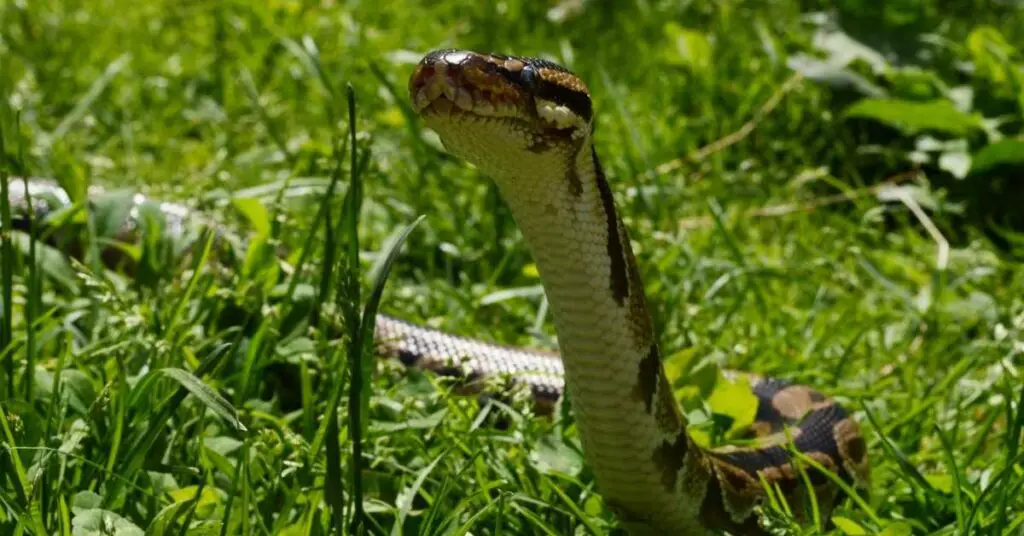We’re an affiliate. We may earn a commission on qualifying purchases through the links on this page. Learn more by reading our disclaimer.
Are ball pythons arboreal? No, ball pythons are not arboreal or even semi-arboreal. Ball pythons are a species of python that lives on the ground and spend a lot of time in burrows.
There is some debate over whether or not ball pythons are arboreal. Some people say that they are, because they are known to climb trees and other structures both in captivity and in the wild. Others argue that they are not, because they do not spend the majority of their time in trees.
In this blog post, we will explore both sides of the argument and come to a conclusion about whether or not ball pythons are arboreal creatures.
Are Ball Pythons Arboreal?
No, ball pythons are the perfect example of a terrestrial reptile which means that they spend pretty much all of their time on the ground or in burrows. They will bask in the sun, cool off in the shade or in a burrow, hunt their prey in the grass, and even sleep on the ground level.

What Are Arboreal Animals?
Reptiles and animals that are classified as arboreal are animals that live in trees. This means that instead of living on the ground they spend the majority of their time up in the trees.
These animals will hunt things like small mammals or birds in the trees and a lot of time will be camouflaged in the leaves or branches of the trees which will help them snatch an easy meal.
Arboreal reptiles and animals will also sleep right there in the trees which will help to protect them from potential predators.
Here are some examples of arboreal animals and reptiles:
Arboreal Animals
- Monkeys
- Sloths
- Koalas
Arboreal Reptiles
- Emerald Tree Boa
- Green Tree Python
- Veiled Chameleons
Where Are Ball Pythons From?
Ball pythons are native to the grasslands of Africa. They are primarily indigenous to the grasslands in central and western Africa where they spend most of the time in burrows to stay hidden from potential predators.
They come out of their burrows in search of prey such as mice, rats, and other ground-dwelling mammals.
They primarily hunt on the ground but have been known to follow prey up into the lower trees after small birds or rodents that try to flee their grasp.
This is a lot of times why we think that they are arboreal or at least semi-arboreal is we see them hunting or chasing prey in the lower branches of a tree.
Just because they will sometimes track birds in trees, this does not make them arboreal. The simple truth is that pretty much all snakes are good climbers so it only makes sense that they would climb some, especially when it comes to a meal.
Do Male or Female Ball pythons Spend More Time in Trees than the other?
No, male and female ball pythons both spend the majority of time on the ground and in the burrows. It isn’t uncommon to see smaller ball pythons chasing prey into small trees to get an easy meal.
Male ball pythons do tend to be smaller than female specimens when fully grown. Males typically reach 3-4 feet whereas females can reach 4-5 feet in length.
It isn’t uncommon for smaller specimens to go up into the trees in search for food as they can generally move about in the trees a little easier.
Since the males tend to be smaller in overall size than the females it makes sense that it would be males that would venture into the trees on those rare occasions.
Do Ball Pythons Climb Branches?
Yes, occasionally ball pythons will climb branches either that on are on the ground or low limbs in trees in search of food such as eggs or baby chicks in a nest. Ball pythons and other snakes are good climbers and will climb when looking for prey when the food is sparce. However, this does not make them truly arboreal.
Should I put Branches In My Ball Python’s Tank?
Since ball pythons are not arboreal but rather go into the trees only in certain situations like looking for food or in search of a possible mate, it is not necessary for you to include branches or limbs in your ball python’s enclosure.
Though it is not required, you can incorporate a branch into your tank design as it is common for branches to fall out of trees and land on the ground. Ball pythons would slither across a branch on the ground regularly.
The overall tank design and decorations are really just a matter of preference so feel free to set it up however you like as long as you are providing your ball python with the things that it needs.
- A warm side to the enclosure
- A cool side to the enclosure
- A moist hide to aid in shedding
- Ample space in the enclosure
- Space to burrow
Here is a full guide to setting up a great enclosure for your ball python:
Are There Any Truly Arboreal Python Species?
Yes, there are arboreal species of pythons. There are fewer arboreal pythons than there are terrestrial species. There are nearly 40 species of pythons that are like ball pythons and spend their days on the ground rather than in trees whereas there are only a few species that fall into the arboreal category.
One of the most well known arboreal pythons is the green tree python. It has a strong tail and longer teeth than that of its terrestrial cousin the ball python.
The strong tail helps the green tree python grip the tree branches so that it can strike prey as it flies by or lands on a nearby branch and the longer teeth can pierce through feathers and thicker skin.
In addition to the green tree python, there are other species of arboreal or semi-arboreal pythons including Carpet Pythons, Bredlis, Amethystine Python, and Olive Pythons.
These are all examples of arboreal or at least semi-arboreal pythons that spend some time in the trees.
Frequently Asked Questions (FAQs)
Here are some of the most asked questions:
Are Ball Pythons Ground Dwelling?
Yes, ball pythons are a ground dwelling species meaning that they spend most of their time on the ground floor of the grassland and in burrows.
Do Ball Pythons Hang out In Trees?
Ball pythons do not typically “hang out” in trees but they have been known to venture into trees while hunting prey or to potentially stay clear of a threat. Things like heavy rains will sometimes force different wildlife into the trees to avoid floor water.
Do Ball Pythons Like Vertical Enclosures?
Ball pythons prefer more of a terrestrial enclosure with more ground space and will spend most of their time coiled in or around their hides.
This is their nature in the wild as well as they spend most of their day in burrows only to venture out in search of food or a mate.
With that being said though, even a ground dwelling or terrestrial species like ball pythons will still have to navigate over branches and down trees in the wild during their search for food so it would also make sense in their enclosure.
You can certainly give them some vertical space in their enclosure to climb as it won’t hurt and your ball python will likely explore its home.
Do Ball Pythons Like Branches?
Yes, and no. Ball pythons do like to occasionally climb branches in the wild in search of food but in captivity this is not the case really as they do not have to hunt for their food.
If there is branches on the ground then you ball python will climb over it and a lot of times you will find it coiled up underneath or behind the branch.
When it comes to whether ball pythons like branches or not in their enclosure, some might climb on branches that you put into their tank. You can use branches of driftwood that you have found yourself and properly sterilized or something that you have purchased.
Do Ball Pythons Need Height?
No, ball pythons are terrestrial snakes which means that they are ground dwellers and as such will spend most of their time on the ground and in their burrows.
When it comes to picking out a tank or enclosure for your ball python, you should get one that is almost as long as your ball python so that your python can stretch out.
The vertical height or space in the tank isn’t really a factor since ball pythons are terrestrial but if you want to give them some vertical space or want the tank to look more natural or add depth to the tank, you can go with one that has some height to it.
In Conclusion
So, there you have it. Contrary to popular belief, ball pythons are not arboreal snakes. They are a terrestrial species that spends most of their time on the ground in their burrows.
This means that when considering an enclosure for your pet ball python, make sure to provide plenty of substrate for them to dig into and create their own hiding spots.
And remember, if you’re ever unsure about what type of habitat is best for your snake, always consult with an expert!
